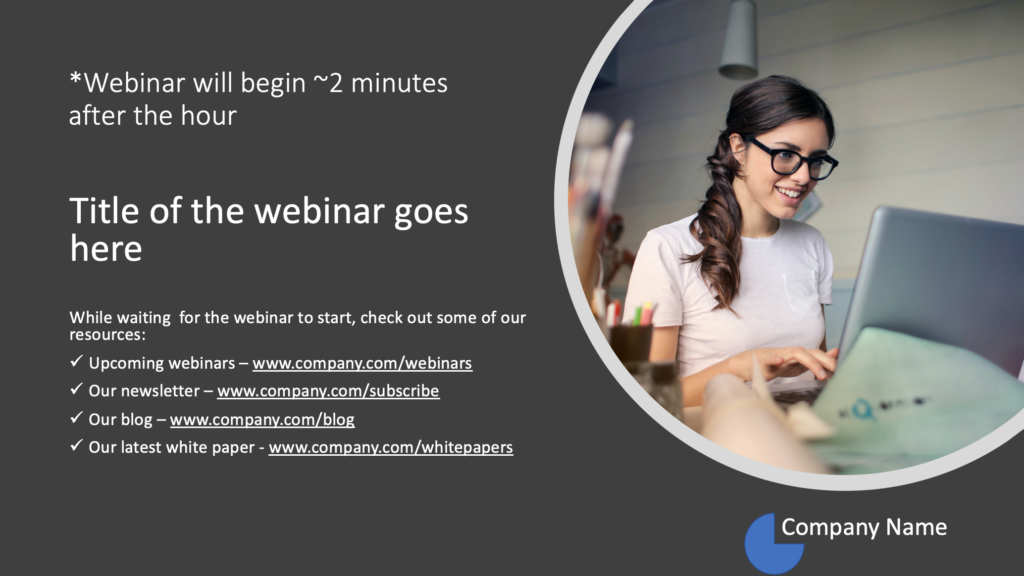One of the conundrums when hosting webinars is determining whether to start the webinar promptly at the promoted start time or delay when you begin by a few minutes?
I’ve been monitoring for the last 12 years when people actually join a webinar. And while the percentages can vary from webinar to webinar for a variety of reasons, a good rule of thumb is that a third to one-half of the number of attendees who will eventually join the live webinar do so at or within 15-30 seconds of the scheduled start time.
But the other half or more may not join until 2-3 minutes after the scheduled state time. And a small percentage will join between 3-5+ minutes.
What Causes Webinar Registrants to Join Late?
There are numerous reasons people join webinars a few minutes late, but the most common ones include:
- They are just finishing up a previous call or meeting that ended at or after the webinar start time.
- They need a bio break or want to get some water, coffee or a snack so they can attend your hour-long webinar without needing to step away and miss something. With so many people working from home currently, there can be an easy temptation to walk to the kitchen to get a coffee refill, snack, or let the dog outside.

- They simply forgot and then suddenly remembered your webinar when looking at their calendar or seeing a reminder notification.
- They didn’t see any webinar reminder notifications (or you didn’t send any), and something else reminded them.
- They remembered the webinar but then couldn’t find the link to join, were confused, or couldn’t find any required login passcodes or phone numbers. Or with long or confusing or jumbled text in an email reminder, they might type in a passcode incorrectly or confuse the webinar number with a passcode. All this can add up to a delay of 30 to 60 seconds.
- The webinar software platform you use requires downloading and installing software or a plug-in which might take 30-60 seconds.
- They are simply trying to finish up a Slack conversation, finish sending an email, or other tasks that they want to complete before they join the webinar so they don’t have to multitask and worry about anything during your webinar.
- And some people simply may join a few minutes late because they know the first few minutes of most webinars are used for administrative purposes such as tips on using the webinar software, background on the companies or the presenters, or the introduction of speakers.
- Attendees will often have technical issues when they first login, such as not hearing any sound or having issues with the software plugin. (I recently experienced this myself on someone’s webinar and then had to switch and login via the web browser option – all which added a few minutes delay to my joining the webinar.)
- If they’re using a dial-in conference bridge it can easily take several seconds to connect in and people frequently struggle to find webinar ID and passcode or correct phone number – or enter them in the wrong order (or maybe this is just me??).
Tips to Increase the Percentage of Prompt Attendees
If we know that potentially half or more of attendees might show up late, what can you do to increase both the percentage of attendees versus registrants, but also to get more attendees to arrive on time? Following are a few tips:
- Send email reminders the day before and one or two the day of the webinar. Depending on the time of day the webinar starts and where most of your registrants are located, you will want to send one about an hour before and perhaps about 4 hours before the webinar start time.
- If possible don’t just use the default reminder message from your webinar platform, but customize it with any new information, updates on key information or assets such as white papers, tip sheets or other things of value that will be provided to attendees of the webinar. Also if your webinar includes a well-known expert you might want to remind registrants that they will only be able to ask the expert questions during the live webinar.
- Include add to calendar functionality in your initial registration conference confirmation email.

- If you have the capabilities, also consider testing an optional SMS reminder (get permission during registration) sent to registrants perhaps 15 minutes before webinar start time.
- Use your social media channels to promote that the webinar starts in 4 and 1 hours (as an example). While these social promotions are generally designed to drive new registrations, for people engaged with your brand these social posts can serve as additional reminders to existing registrants.
So Then, What Is the Best Time to Actually Begin A Webinar?
So now that we’ve outlined the steps you can take to increase the number of registrants to actually show up on time for the start of your webinar, let’s explore the actual start time options.
Exactly at the promoted start time: You start the webinar exactly (or perhaps within 10-15 seconds) of your advertised start time. The pros and cons of this approach are:
- You are being very prompt and showing respect for people’s valuable time.
- You also don’t lose any precious few minutes that could be used at the end of your webinar for answering an extra one or two questions.
- The downside of course as outlined earlier is that about 50% (or more) of your audience will miss the first few minutes of your webinar.
1-2 minutes after the promoted start time: A second option is to start the webinar 1 to 2 minutes after the promoted start time.
- Potential downside of this approach for those attendees that show-up early or right on time is they might feel slightly annoyed with having to wait a few minutes and a small percentage might get distracted and end up moving onto another activity.
Tip: If your webinar solution offers the option, make sure you have “hold” music playing before the webinar starts. Without hold music, attendees might get concerned that the webinar started but they just can’t hear the speakers.
- The benefit of this approach is that you’ll likely get about 80% or more of eventual webinar attendees joining by the time you start the webinar. This ensures that most attendees hear the opening announcements, tips about using the webinar solution, speaker introductions, and the all-important reminder, that yes, attendees will get a copy of the presentation.
Tip: The webinar moderator can make a couple of announcements during the pre-webinar start time.
- A great technique I heard from Tami Forman of PathForward is to use this “waiting” period at the beginning of a webinar to conduct a poll. Tami shared an example from one webinar focused on when people are looking to pivot their career: “Why are you looking to pivot?” and the provided answers were based on different reasons the organization had been hearing.
- Other approaches to fill the ~2 minutes are to play a short video, share examples of resources and content that is available and what they might receive by attending the webinar, promote upcoming webinars and events instead of or in addition to doing so at the end of the webinar.
- If you use the delayed start time approach, it is important however to manage expectations and communicate when you will start to live webinar. (See our quick tip on using the title slide to manage expectations.)

The official webinar start time is not at the top of the hour but something like 5, 10 or 15 minutes after the hour: I haven’t seen this approach used very often, but it might be a technique worth testing, especially if you are seeing a high percentage of attendees showing up after your webinars start. Some pros and cons of this approach:
- It does allow registrants time between calls and meetings, to send a few emails and other tasks and then jump on your webinar in plenty of time.
- Having a webinar start time at say at 1:05, 1:10, or 1:15 PM instead of 1:00 PM is an atypical start time that might confuse some attendees. Some people may assume it would start at the top of the hour, get impatient and then move on to another activity.
- This approach in theory reduces the amount of time you have for a webinar from say 60 minutes to 45 (or a 15 minute after the hour start). But if you’re only planning on say 30 minutes of content and 15 minutes for Q&A this could be an ideal approach.
What time do you start your webinars – on time, delayed, or at an atypical start time? Let us know in the comments what you approaches you’ve used what worked best for you.
